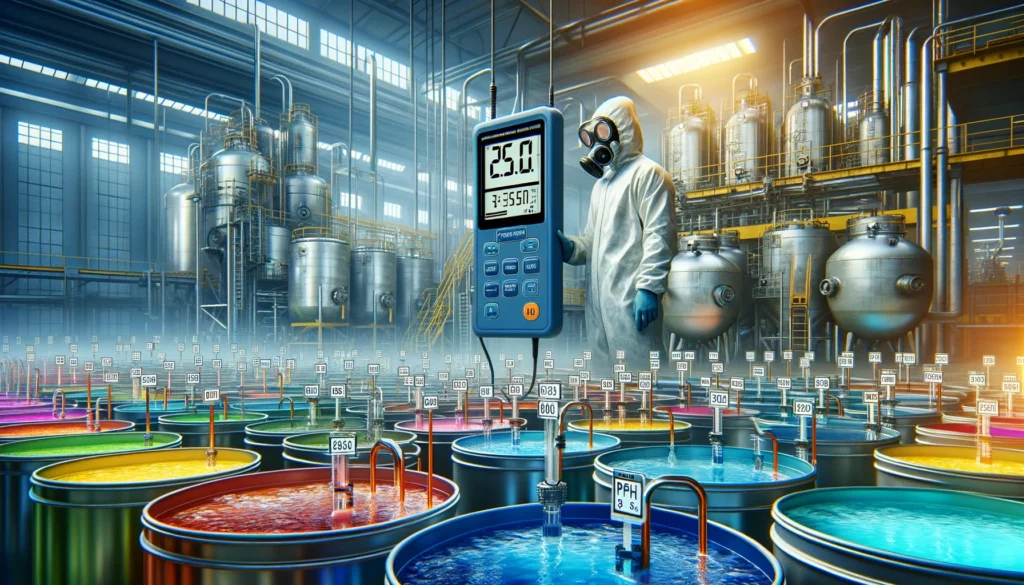pH, a term we often encounter in science classes, profoundly influences both the natural world and our daily lives. This simple scale, ranging from acidic to alkaline, is a cornerstone of chemical science, underpinning countless processes from the metabolic pathways in our bodies to the functioning of ecosystems. Despite its scientific origins, the concept of pH extends far beyond the laboratory. It plays a pivotal role in the culinary arts, health and beauty, agriculture, and even home cleaning.
Understanding pH is not just about grasping a chemical property; it’s about recognizing its ubiquitous impact on the things we eat, the products we use, and the environment we live in. This blog will delve into the fascinating world of pH, unraveling its complexities and shedding light on its practical applications in our everyday existence.
Understanding pH
pH, standing for ‘potential of Hydrogen,’ is a measure that indicates the acidity or alkalinity of a solution on a scale from 0 to 14. This scale is logarithmic, meaning each whole number change represents a tenfold increase or decrease in acidity or alkalinity. Substances with a pH below 7 are acidic, and those above 7 are alkaline. A pH of 7 is neutral, representing a balance between acidity and alkalinity, exemplified by pure water.
At the core of the pH concept is the presence of hydrogen ions (H+) and hydroxide ions (OH-). In acidic solutions, hydrogen ions predominate, whereas alkaline solutions have more hydroxide ions. The pH scale is a reflection of the ratio of these ions in a solution. For example, lemon juice, with a pH around 2, is highly acidic due to its high concentration of hydrogen ions. Conversely, bleach, having a pH above 12, is strongly alkaline with a high concentration of hydroxide ions.

Understanding pH is crucial because it affects the chemical behavior of substances. For instance, the pH of a solution can influence the solubility of compounds, the rate of chemical reactions, and the stability of molecules. This is why pH is a fundamental concept in chemistry and biochemistry, as it affects how substances interact in a solution.
Common everyday substances exhibit a wide range of pH values. Gastric acid in the stomach is extremely acidic, with a pH of 1 to 2, aiding in digestion. Blood, vital for transporting nutrients and oxygen, maintains a slightly alkaline pH of about 7.4, showing the body’s tight regulation of pH for proper physiological function. On the other hand, household ammonia, a common cleaner, is alkaline with a pH of about 11.
By understanding pH, we gain insights into the chemical properties that define the acidity or alkalinity of substances, helping us to predict and manipulate their behavior in various scientific and practical applications.
The Role of pH in Everyday Life
pH plays a crucial role in our daily lives, influencing everything from the food we eat to the health of our bodies and the environment we live in. Its impact is so pervasive that understanding pH can help us make better choices in various aspects of life.
In the culinary world, pH is a key factor in flavor, food preservation, and safety. The tanginess of lemons, the sourness of yogurt, and the bitterness of coffee are all attributes influenced by pH levels. Fermentation processes, essential for making bread, cheese, and wine, depend on specific pH conditions to control microbial growth and activity. Food preservation techniques, like pickling, rely on acidic conditions to prevent spoilage and kill harmful bacteria, ensuring the products are safe to consume.

Human health is closely tied to the pH balance within the body. Our blood, for instance, must maintain a slightly alkaline pH of 7.35 to 7.45 to function properly. Deviations from this range can lead to health issues, demonstrating the body’s need for homeostasis. The skin’s protective barrier, known as the acid mantle, has a slightly acidic pH, which helps to inhibit the growth of harmful bacteria and fungi, protecting us from infections and maintaining skin health.
Gardening and agriculture also illustrate the significance of pH. Soil pH affects the availability of nutrients to plants and the activity of soil microorganisms. For instance, blueberries thrive in acidic soil (pH 4.5 to 5.5), while vegetables like broccoli and cabbage prefer slightly alkaline conditions. Gardeners often adjust soil pH by adding lime to increase alkalinity or sulfur to increase acidity, optimizing the growth conditions for different plants.
Even in home cleaning, pH matters. Acidic cleaners, like vinegar, are effective at removing mineral deposits and rust, while alkaline cleaners, such as baking soda, are great for cutting through grease and lifting dirt. Understanding the pH of cleaning agents can lead to more effective and safer cleaning practices.
In summary, pH influences various aspects of everyday life, from the food we consume and the way we maintain our health to the success of our gardening efforts and the efficiency of our cleaning routines. By recognizing and applying our knowledge of pH, we can enhance food quality, improve health outcomes, optimize plant growth, and achieve better cleaning results.
pH in Industrial Applications
In the industrial realm, pH measurement and control are critical for ensuring product quality, safety, and environmental compliance. Various industries rely on precise pH management to optimize processes, reduce waste, and maintain safety standards.
In water treatment facilities, pH monitoring is essential for ensuring water quality and safety. Treatment processes often require pH adjustments to remove contaminants effectively. For instance, raising the pH can cause heavy metals to precipitate out of solution, making them easier to remove. Similarly, controlling pH helps in the disinfection process, where certain pH levels can enhance the effectiveness of chlorination, eliminating harmful pathogens and ensuring safe drinking water for communities.
The pharmaceutical industry also places great importance on pH. The development and manufacturing of drugs often involve chemical reactions that are pH-sensitive. The stability, solubility, and absorption of pharmaceutical compounds can be significantly affected by pH levels. For example, many medications are designed to dissolve at specific pH levels to ensure they are released and absorbed in the body at the right location, maximizing their therapeutic effect.

Chemical manufacturing is another area where pH is vital. Many chemical reactions require specific pH conditions to proceed correctly and efficiently. Controlling pH can influence the rate of reaction, yield of product, and purity of the final product. In the production of textiles, for instance, pH control is crucial in the dyeing process to ensure that colors bind properly to fabrics without fading or washing out.
Environmental monitoring also relies heavily on pH measurement. The pH of natural water bodies can indicate the health of the ecosystem and the presence of pollutants. Acidic or alkaline conditions in lakes and rivers can affect aquatic life, influencing the survival of fish and plants. Regulatory agencies often monitor the pH of wastewater and industrial discharges to prevent environmental damage and ensure that companies comply with pollution control standards.
Overall, the importance of pH in industrial applications cannot be overstated. Its role in water treatment, pharmaceuticals, chemical manufacturing, and environmental monitoring underscores the necessity of precise pH control in maintaining quality, safety, and environmental integrity in industrial processes.
Measuring and Adjusting pH
Measuring and adjusting pH are fundamental practices in both laboratory and real-world applications, critical for scientific research, industrial processes, and everyday life. The methods and tools used for these purposes vary in complexity, accuracy, and application, catering to different needs and contexts.
For measuring pH, simple litmus paper or pH strips offer quick, color-based indicators, changing hue to reflect acidic or alkaline conditions. These are popular in educational settings and for home use, providing a basic understanding of pH levels. More precise measurements require electronic pH meters, which use a probe to detect the hydrogen ion activity in a solution, offering detailed and accurate pH readings. These meters are essential in labs and industries where specific pH values must be maintained.

Adjusting pH is often necessary to optimize conditions for chemical reactions, biological processes, or product stability. In gardening, for example, lime is added to soil to reduce acidity and raise pH, making the environment more suitable for alkaline-loving plants. Conversely, sulfur can lower soil pH to accommodate acid-loving species. In swimming pools, pH is meticulously managed using acids or bases to ensure water safety and comfort, preventing irritation to eyes and skin, and protecting equipment from corrosion.
In industrial settings, chemicals like hydrochloric acid or sodium hydroxide are used to adjust the pH of solutions, ensuring optimal conditions for manufacturing processes. These adjustments are made carefully, monitored by pH meters, to maintain the delicate balance required for product quality and process efficiency.
Understanding and controlling pH is essential for a myriad of applications, from ensuring the health of a backyard garden to maintaining the rigorous standards of industrial production. The ability to measure and adjust pH accurately is a cornerstone of many scientific and practical endeavors, highlighting the pervasive importance of this chemical property in our world.
Conclusion
The exploration of pH reveals its profound significance across a spectrum of domains, from the minute scale of cells to the expansive realms of ecosystems and industries. This simple yet powerful concept serves as a linchpin in understanding chemical interactions and their impacts on our daily lives and the environment. The ability to measure and manipulate pH allows us to optimize food flavors, maintain health, cultivate gardens, execute industrial processes, and protect natural resources.
By delving into the world of pH, we gain not only scientific insight but also practical knowledge that enhances the quality of life and fosters environmental stewardship. As we continue to uncover the intricacies of pH and its applications, we equip ourselves with the tools to navigate and harmonize with the chemical dynamics that shape our world.

Author’s Note
This blog post aims to demystify the concept of pH and highlight its ubiquitous role in our daily lives and industrial processes. Our journey through the acidic and alkaline nuances of pH strives to provide a comprehensive understanding that bridges the gap between complex chemical theory and practical, everyday applications.
G.C., Ecosociosphere contributor.
References and Further Reading
- “Chemistry for Dummies” by John T. Moore – A beginner-friendly guide that includes easy explanations of chemical principles, including pH.
- “The pH Miracle: Balance Your Diet, Reclaim Your Health” by Robert O. Young and Shelley Redford Young – Explores the importance of pH balance in the body and its impact on health.




